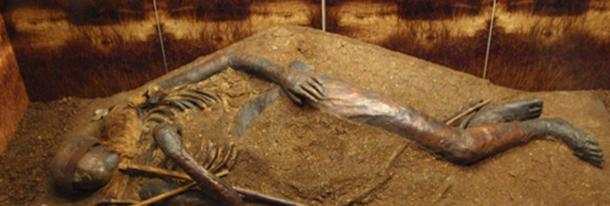Windeby I is a bog body that was discovered in a peat bog located in the town of Windeby, near Schleswig, in the northern part of Germany. This bog body was discovered in the middle of the 20th century when peat from a bog was being cut by locals.
Initially, the bog body was dubbed as the ‘Windeby Girl’, as it was believed that the body belonged to a 14-year-old female. In more recent times, however, this designation has been re-ᴀssessed, and it is now agreed that these are in fact the mummified remains of a male individual.

Discovering a Bog Body
In 1952, the owners of a local northern German estate decided to harvest peat from a bog to be sold as fuel. While the peat was being cut by the workers, they stumbled upon something rather unexpected, i.e. the bog body . The peat cutters were forced to stop their work immediately so that the body could be studied.
Unfortunately, the machinery used for the peat cutting had already severed one of the body’s legs, one of its feet, as well as one of its hands. Still, as the body had been well-preserved by the peat, it was considered an important archaeological discovery.

There were no grave goods found with the Windeby I bog body, apart from a woolen band covering the eyes and a collar around the neck. For the former, it has been suggested that it had either been used to cover the corpse’s eyes after death, or to hold the hair back, in which case the band would have slipped down over the eyes due to the shrinkage of the body. Based on the body’s slender build, it was initially ᴀssumed that it belonged to a female. Another important aspect of this bog body is that it seemed its head was partly shaved.
Close to where Windeby I was found, another bog body was unearthed. This time, it belonged to a middle-aged man who had been strangled with a hazel branch, and then placed in the bog on a stake.

Interpreting the Remains…According to a Roman Historian
The archaeologists turned to the Roman historian Tacitus to provide an explanation for the two bog bodies found at Windeby. According to Tacitus, the Germanic tribes that lived beyond the Rhine had the custom of punishing wrong-doers by having their executed bodies staked in bogs. With this information in hand, for a long time researchers believed that the two bog bodies belonged to an adulterous couple who were caught and punished.
However, it is worth noting that Tacitus’s writings on the customs practiced by the Germanic tribes were based on second or even third hand accounts. In addition, Tacitus intended to shame his Roman readers for what he perceived as decadent behavior. Therefore, the accuracy of this ancient source may be called into question.
Another challenge to this interpretation is that the Windeby I bog body displayed no signs of trauma, as one would expect if the person had been executed . Instead, the remains suggest that the person had suffered from repeated bouts of illness or malnutrition, which finally resulted in death.
The explanation of the ‘partly shaved’ head is that one side of the head was more exposed to oxygen than the other, causing the hair on that side of the head to suffer a greater rate of decay . Alternatively, the hair might have been accidentally damaged by the archaeologists who were conducting the excavation.

Reᴀssessing the Windeby ‘Female’ Body
Even during the 1970s, scientists and archaeologists were not able to say that the Windeby I bog body belonged to a female, though this remained the consensus. This view changed in 2007, when a re-ᴀssessment of the body using DNA analysis suggested that it was more likely that the Windeby I body belonged to a male.
In addition, radiocarbon dating of the two bodies from Windeby also revealed that they are not contemporaneous, and that the so-called “ male lover ” was in fact 300 years older than Windeby I.
Today, both of the bog bodies from Windeby (along with another bog body, a headless body, and a bodiless head), are housed in the Landesmuseum in Schleswig-Holstein, Germany, where they can be seen by curious visitors.





